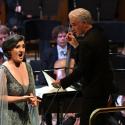You wouldn’t guess it from her name, but Janina Fialkowska isn’t actually Polish. You wouldn’t guess from her Chopin either, which is sensitive and supple, always emotive and deeply idiomatic. The Canadian pianist (her father was Polish) has recently come to wider attention for her Chopin interpretations through a series of well-received albums on the ATMA label, making this all-Chopin Wigmore Hall recital a particularly attractive proposition.
There is a directness to Fialkowska’s interpretations that is both disarming and immediately engaging. The melody always leads, with the left-hand chords providing texture and background as much as harmonic support. Contrasts – of phrases, sections, dynamics – are duly acknowledged but never exaggerated for dramatic effect. Even her programme avoided the extremes of Chopin’s output: the only Nocturne was one of the most upbeat, the Op. 9/3, and although she presented two scherzos, one of them, No. 4, was a surprisingly relaxed affair.
Time seemed to stand still as the harmonic progressions dissolved into pure texture
There were occasional fireworks here, but these were carefully spaced to structure the programme. The first half was organised around the tumultuous Ballade No. 2 and the equally virtuosic F-Minor Fantasie, Op. 49. Fialkowska’s technique here was impeccable, every note precisely placed, but with judicious pedalling to blend together the cascading passages. The finale of the Fantasie was particularly effective for the subtlety with which it was prepared, Fialkowska gradually increasing the dynamic, yet all the time maintaining the warmth of tone and evenness of texture. Between these towering peaks, two waltzes, Opp. 69/2 and 42, presented together as a pair. Here, and in the other dance-based works, the Polonaise, Op. 26/2, and the Three Mazurkas, Op. 50, Fialkowska took surprising liberties with the underlying beat, yet did so with such grace and assurance that the offset rhythms felt entirely natural.
The Fourth Scherzo that opened the second half felt a little underplayed, as if the sheer decorum (a key Chopin virtue) had finally got the better of the music’s emotional thrust. But the Op. 28 Preludes that followed (Nos. 14 and 15) returned us the immediacy and engagement that had characterised the first half. The "Raindrop" Prelude was a highlight, the deep chordal passages of the central section delivered with an intensity and focus, given all the more expressive power by the moderate dynamic.
To conclude, a truly memorable reading of the Scherzo No. 1, Op. 20. Melody again predominated, with Fialkowska providing the ideal balance between discipline and expressive freedom. In the central section, time seemed to stand still, as the harmonic progressions dissolved into pure texture. And then a return of the tumultuous power that Fialkowska keeps in reserve and only rarely sets loose, for a stunning bravura finale.













Add comment